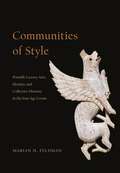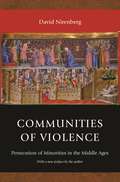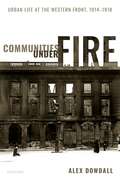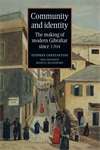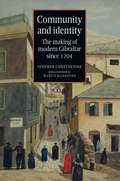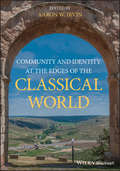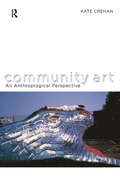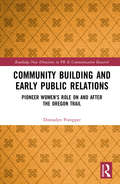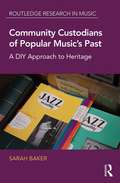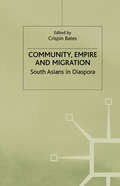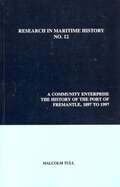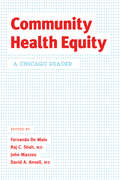- Table View
- List View
Communities of Style: Portable Luxury Arts, Identity, and Collective Memory in the Iron Age Levant
by Marian H. FeldmanCommunities of Style examines the production and circulation of portable luxury goods throughout the Levant in the early Iron Age (1200–600 BCE). In particular it focuses on how societies in flux came together around the material effects of art and style, and their role in collective memory. Marian H. Feldman brings her dual training as an art historian and an archaeologist to bear on the networks that were essential to the movement and trade of luxury goods—particularly ivories and metal works—and how they were also central to community formation. The interest in, and relationships to, these art objects, Feldman shows, led to wide-ranging interactions and transformations both within and between communities. Ultimately, she argues, the production and movement of luxury goods in the period demands a rethinking of our very geo-cultural conception of the Levant, as well as its influence beyond what have traditionally been thought of as its borders.
Communities of Style: Portable Luxury Arts, Identity, and Collective Memory in the Iron Age Levant
by Marian H. FeldmanCommunities of Style examines the production and circulation of portable luxury goods throughout the Levant in the early Iron Age (1200–600 BCE). In particular it focuses on how societies in flux came together around the material effects of art and style, and their role in collective memory. Marian H. Feldman brings her dual training as an art historian and an archaeologist to bear on the networks that were essential to the movement and trade of luxury goods—particularly ivories and metal works—and how they were also central to community formation. The interest in, and relationships to, these art objects, Feldman shows, led to wide-ranging interactions and transformations both within and between communities. Ultimately, she argues, the production and movement of luxury goods in the period demands a rethinking of our very geo-cultural conception of the Levant, as well as its influence beyond what have traditionally been thought of as its borders.
Communities of Style: Portable Luxury Arts, Identity, and Collective Memory in the Iron Age Levant
by Marian H. FeldmanCommunities of Style examines the production and circulation of portable luxury goods throughout the Levant in the early Iron Age (1200–600 BCE). In particular it focuses on how societies in flux came together around the material effects of art and style, and their role in collective memory. Marian H. Feldman brings her dual training as an art historian and an archaeologist to bear on the networks that were essential to the movement and trade of luxury goods—particularly ivories and metal works—and how they were also central to community formation. The interest in, and relationships to, these art objects, Feldman shows, led to wide-ranging interactions and transformations both within and between communities. Ultimately, she argues, the production and movement of luxury goods in the period demands a rethinking of our very geo-cultural conception of the Levant, as well as its influence beyond what have traditionally been thought of as its borders.
Communities of Violence: Persecution of Minorities in the Middle Ages
by David NirenbergIn the wake of modern genocide, we tend to think of violence against minorities as a sign of intolerance, or, even worse, a prelude to extermination. Violence in the Middle Ages, however, functioned differently, according to David Nirenberg. In this provocative book, he focuses on specific attacks against minorities in fourteenth-century France and the Crown of Aragon (Aragon, Catalonia, and Valencia). He argues that these attacks--ranging from massacres to verbal assaults against Jews, Muslims, lepers, and prostitutes--were often perpetrated not by irrational masses laboring under inherited ideologies and prejudices, but by groups that manipulated and reshaped the available discourses on minorities. Nirenberg shows that their use of violence expressed complex beliefs about topics as diverse as divine history, kinship, sex, money, and disease, and that their actions were frequently contested by competing groups within their own society. Nirenberg's readings of archival and literary sources demonstrates how violence set the terms and limits of coexistence for medieval minorities. The particular and contingent nature of this coexistence is underscored by the book's juxtapositions--some systematic (for example, that of the Crown of Aragon with France, Jew with Muslim, medieval with modern), and some suggestive (such as African ritual rebellion with Catalan riots). Throughout, the book questions the applicability of dichotomies like tolerance versus intolerance to the Middle Ages, and suggests the limitations of those analyses that look for the origins of modern European persecutory violence in the medieval past.
Communities of Violence: Persecution of Minorities in the Middle Ages (PDF)
by David NirenbergIn the wake of modern genocide, we tend to think of violence against minorities as a sign of intolerance, or, even worse, a prelude to extermination. Violence in the Middle Ages, however, functioned differently, according to David Nirenberg. In this provocative book, he focuses on specific attacks against minorities in fourteenth-century France and the Crown of Aragon (Aragon, Catalonia, and Valencia). He argues that these attacks--ranging from massacres to verbal assaults against Jews, Muslims, lepers, and prostitutes--were often perpetrated not by irrational masses laboring under inherited ideologies and prejudices, but by groups that manipulated and reshaped the available discourses on minorities. Nirenberg shows that their use of violence expressed complex beliefs about topics as diverse as divine history, kinship, sex, money, and disease, and that their actions were frequently contested by competing groups within their own society. Nirenberg's readings of archival and literary sources demonstrates how violence set the terms and limits of coexistence for medieval minorities. The particular and contingent nature of this coexistence is underscored by the book's juxtapositions--some systematic (for example, that of the Crown of Aragon with France, Jew with Muslim, medieval with modern), and some suggestive (such as African ritual rebellion with Catalan riots). Throughout, the book questions the applicability of dichotomies like tolerance versus intolerance to the Middle Ages, and suggests the limitations of those analyses that look for the origins of modern European persecutory violence in the medieval past.
Communities under Fire: Urban Life at the Western Front, 1914-1918
by Alex DowdallBetween 1914 and 1918, the Western Front passed through some of Europe's most populated and industrialised regions. Large towns including Nancy, Reims, Arras, and Lens lay at the heart of the battlefield. Their civilian inhabitants endured artillery bombardment, military occupation, and material hardship. Many fled for the safety of the French interior, but others lived under fire for much of the war, ensuring the Western Front remained a joint civil-military space. Communities under Fire explores the wartime experiences of civilians on both sides of the Western Front, and uncovers how urban communities responded to the dramatic impact of industrialized war. It discusses how war shaped civilians' personal and collective identities, and explores how the experiences of military violence, occupation, and forced displacement structured the attitudes of civilians at the front towards the rest of the nation. Drawing on a vast array of archival sources, letters, diaries, and newspapers in English, French, and German, it reveals the history of the Western Front from the perspective of its civilian inhabitants. From Leningrad to Warsaw, Hamburg, and, more recently, Sarajevo and Donetsk, urban violence has remained a feature of warfare in Europe, turning cities into battlefields. On each occasion, civilian populations were at the heart of military operations, and forced to adapt to life in a warzone. This was also the case between 1914 and 1918, despite the myth that the First World War was predominantly a soldiers' war. The civilian inhabitants of the Western Front were among the first to suffer the full impact of modern, industrialized war in an urban setting. Communities under Fire explains the multiple ways by which these urban residents responded to, were changed by, succumbed to, or survived the enormous pressures of life in a warzone.
Communities under Fire: Urban Life at the Western Front, 1914-1918
by Alex DowdallBetween 1914 and 1918, the Western Front passed through some of Europe's most populated and industrialised regions. Large towns including Nancy, Reims, Arras, and Lens lay at the heart of the battlefield. Their civilian inhabitants endured artillery bombardment, military occupation, and material hardship. Many fled for the safety of the French interior, but others lived under fire for much of the war, ensuring the Western Front remained a joint civil-military space. Communities under Fire explores the wartime experiences of civilians on both sides of the Western Front, and uncovers how urban communities responded to the dramatic impact of industrialized war. It discusses how war shaped civilians' personal and collective identities, and explores how the experiences of military violence, occupation, and forced displacement structured the attitudes of civilians at the front towards the rest of the nation. Drawing on a vast array of archival sources, letters, diaries, and newspapers in English, French, and German, it reveals the history of the Western Front from the perspective of its civilian inhabitants. From Leningrad to Warsaw, Hamburg, and, more recently, Sarajevo and Donetsk, urban violence has remained a feature of warfare in Europe, turning cities into battlefields. On each occasion, civilian populations were at the heart of military operations, and forced to adapt to life in a warzone. This was also the case between 1914 and 1918, despite the myth that the First World War was predominantly a soldiers' war. The civilian inhabitants of the Western Front were among the first to suffer the full impact of modern, industrialized war in an urban setting. Communities under Fire explains the multiple ways by which these urban residents responded to, were changed by, succumbed to, or survived the enormous pressures of life in a warzone.
Community and identity: The making of modern Gibraltar since 1704 (PDF)
by Stephen ConstantineThis fluent, accessible and richly informed study, based on much previously unexplored archival material, concerns the history of Gibraltar following its military conquest in 1704, after which sovereignty of the territory was transferred from Spain to Britain and it became a British fortress and colony. Unlike virtually all other studies of Gibraltar, this book focuses on the civilian population. It shows how a substantial multi-ethnic Roman Catholic and Jewish population derived mainly from the littorals and islands of the Mediterranean became settled in British Gibraltar, much of it in defiance of British efforts to control entry and restrict residence. With Gibraltar’s political future still today contested this is a matter of considerable political importance. Community and identity: The making of modern Gibraltar since 1704 will appeal to both a scholarly and a lay readership interested particularly in the ‘Rock’ or more generally in nationality and identity formation, colonial administration, decolonisation and the Iberian peninsula.
Community and identity: The making of modern Gibraltar since 1704
by Stephen ConstantineThis fluent, accessible and richly informed study, based on much previously unexplored archival material, concerns the history of Gibraltar following its military conquest in 1704, after which sovereignty of the territory was transferred from Spain to Britain and it became a British fortress and colony. Unlike virtually all other studies of Gibraltar, this book focuses on the civilian population. It shows how a substantial multi-ethnic Roman Catholic and Jewish population derived mainly from the littorals and islands of the Mediterranean became settled in British Gibraltar, much of it in defiance of British efforts to control entry and restrict residence. With Gibraltar’s political future still today contested this is a matter of considerable political importance. Community and identity: The making of modern Gibraltar since 1704 will appeal to both a scholarly and a lay readership interested particularly in the ‘Rock’ or more generally in nationality and identity formation, colonial administration, decolonisation and the Iberian peninsula.
Community and Identity at the Edges of the Classical World
by Aaron W. IrvinA timely and academically-significant contribution to scholarship on community, identity, and globalization in the Roman and Hellenistic worlds Community and Identity at the Edges of the Classical World examines the construction of personal and communal identities in the ancient world, exploring how globalism, multi-culturalism, and other macro events influenced micro identities throughout the Hellenistic and Roman empires. This innovative volume discusses where contact and the sharing of ideas was occurring in the time period, and applies modern theories based on networks and communication to historical and archaeological data. A new generation of international scholars challenge traditional views of Classical history and offer original perspectives on the impact globalizing trends had on localized areas—insights that resonate with similar issues today. This singular resource presents a broad, multi-national view rarely found in western collected volumes, including Serbian, Macedonian, and Russian scholarship on the Roman Empire, as well as on Roman and Hellenistic archaeological sites in Eastern Europe. Topics include Egyptian identity in the Hellenistic world, cultural identity in Roman Greece, Romanization in Slovenia, Balkan Latin, the provincial organization of cults in Roman Britain, and Soviet studies of Roman Empire and imperialism. Serving as a synthesis of contemporary scholarship on the wider topic of identity and community, this volume: Provides an expansive materialist approach to the topic of globalization in the Roman world Examines ethnicity in the Roman empire from the viewpoint of minority populations Offers several views of metascholarship, a growing sub-discipline that compares ancient material to modern scholarship Covers a range of themes, time periods, and geographic areas not included in most western publications Community and Identity at the Edges of the Classical World is a valuable resource for academics, researchers, and graduate students examining identity and ethnicity in the ancient world, as well as for those working in multiple fields of study, from Classical, Hellenistic, and Roman historians, to the study of ethnicity, identity, and globalizing trends in time.
Community and Identity at the Edges of the Classical World
by Aaron W. IrvinA timely and academically-significant contribution to scholarship on community, identity, and globalization in the Roman and Hellenistic worlds Community and Identity at the Edges of the Classical World examines the construction of personal and communal identities in the ancient world, exploring how globalism, multi-culturalism, and other macro events influenced micro identities throughout the Hellenistic and Roman empires. This innovative volume discusses where contact and the sharing of ideas was occurring in the time period, and applies modern theories based on networks and communication to historical and archaeological data. A new generation of international scholars challenge traditional views of Classical history and offer original perspectives on the impact globalizing trends had on localized areas—insights that resonate with similar issues today. This singular resource presents a broad, multi-national view rarely found in western collected volumes, including Serbian, Macedonian, and Russian scholarship on the Roman Empire, as well as on Roman and Hellenistic archaeological sites in Eastern Europe. Topics include Egyptian identity in the Hellenistic world, cultural identity in Roman Greece, Romanization in Slovenia, Balkan Latin, the provincial organization of cults in Roman Britain, and Soviet studies of Roman Empire and imperialism. Serving as a synthesis of contemporary scholarship on the wider topic of identity and community, this volume: Provides an expansive materialist approach to the topic of globalization in the Roman world Examines ethnicity in the Roman empire from the viewpoint of minority populations Offers several views of metascholarship, a growing sub-discipline that compares ancient material to modern scholarship Covers a range of themes, time periods, and geographic areas not included in most western publications Community and Identity at the Edges of the Classical World is a valuable resource for academics, researchers, and graduate students examining identity and ethnicity in the ancient world, as well as for those working in multiple fields of study, from Classical, Hellenistic, and Roman historians, to the study of ethnicity, identity, and globalizing trends in time.
Community Art: An Anthropological Perspective
by Kate CrehanExploring key issues for the anthropology of art and art theory, this fascinating text provides the first in-depth study of community art from an anthropological perspective.The book focuses on the forty year history of Free Form Arts Trust, an arts group that played a major part in the 1970s struggle to carve out a space for community arts in Britain. Turning their back on the world of gallery art, the fine-artist founders of Free Form were determined to use their visual expertise to connect, through collaborative art projects, with the working-class people excluded by the established art world. In seeking to give the residents of poor communities a greater role in shaping their built environment, the artists' aesthetic practice would be transformed.Community Art examines this process of aesthetic transformation and its rejection of the individualized practice of the gallery artist. The Free Form story calls into question common understandings of the categories of "art," "expertise," and "community," and makes this story relevant beyond late twentieth-century and early twenty-first-century Britain.
Community Art: An Anthropological Perspective
by Kate CrehanExploring key issues for the anthropology of art and art theory, this fascinating text provides the first in-depth study of community art from an anthropological perspective.The book focuses on the forty year history of Free Form Arts Trust, an arts group that played a major part in the 1970s struggle to carve out a space for community arts in Britain. Turning their back on the world of gallery art, the fine-artist founders of Free Form were determined to use their visual expertise to connect, through collaborative art projects, with the working-class people excluded by the established art world. In seeking to give the residents of poor communities a greater role in shaping their built environment, the artists' aesthetic practice would be transformed.Community Art examines this process of aesthetic transformation and its rejection of the individualized practice of the gallery artist. The Free Form story calls into question common understandings of the categories of "art," "expertise," and "community," and makes this story relevant beyond late twentieth-century and early twenty-first-century Britain.
Community Building and Early Public Relations: Pioneer Women’s Role on and after the Oregon Trail (Routledge New Directions in PR & Communication Research)
by Donnalyn PompperFrom the start, women were central to a century of westward migration in the U.S. Community Building and Early Public Relations: Pioneer Women’s Role on and after the Oregon Trail offers a path forward in broadening PR's Caucasian/White male-gendered history in the U.S. Undergirded by humanist, communitarian, critical race theory, social constructionist perspectives, and a feminist communicology lens, this book analyzes U.S. pioneer women's lived experiences, drawing parallels with PR's most basic functions – relationship-building, networking, community building, boundary spanning, and advocacy. Using narrative analysis of diaries and reminiscences of women who travelled 2,000+ miles on the Oregon Trail in the mid-to-late 1800s, Pompper uncovers how these women filled roles of Caretaker/Advocate, Community Builder of Meeting Houses and Schools, served a Civilizing Function, offered Agency and Leadership, and provided Emotional Connection for Social Cohesion. Revealed also is an inevitable paradox as Caucasian/White pioneer women’s interactional qualities made them complicit as colonizers, forever altering indigenous peoples’ way of life. This book will be of interest to undergraduate and graduate PR students, PR practitioners, and researchers of PR history and social identity intersectionalities. It encourages us to expand the definition of PR to include community building, and to revise linear timeline and evolutionary models to accommodate voices of women and people of color prior to the twentieth century.
Community Building and Early Public Relations: Pioneer Women’s Role on and after the Oregon Trail (Routledge New Directions in PR & Communication Research)
by Donnalyn PompperFrom the start, women were central to a century of westward migration in the U.S. Community Building and Early Public Relations: Pioneer Women’s Role on and after the Oregon Trail offers a path forward in broadening PR's Caucasian/White male-gendered history in the U.S. Undergirded by humanist, communitarian, critical race theory, social constructionist perspectives, and a feminist communicology lens, this book analyzes U.S. pioneer women's lived experiences, drawing parallels with PR's most basic functions – relationship-building, networking, community building, boundary spanning, and advocacy. Using narrative analysis of diaries and reminiscences of women who travelled 2,000+ miles on the Oregon Trail in the mid-to-late 1800s, Pompper uncovers how these women filled roles of Caretaker/Advocate, Community Builder of Meeting Houses and Schools, served a Civilizing Function, offered Agency and Leadership, and provided Emotional Connection for Social Cohesion. Revealed also is an inevitable paradox as Caucasian/White pioneer women’s interactional qualities made them complicit as colonizers, forever altering indigenous peoples’ way of life. This book will be of interest to undergraduate and graduate PR students, PR practitioners, and researchers of PR history and social identity intersectionalities. It encourages us to expand the definition of PR to include community building, and to revise linear timeline and evolutionary models to accommodate voices of women and people of color prior to the twentieth century.
Community Custodians of Popular Music's Past: A DIY Approach to Heritage (Routledge Research in Music)
by Sarah BakerThis book examines do-it-yourself (DIY) approaches to the collection, preservation, and display of popular music heritage being undertaken by volunteers in community archives, museums and halls of fame globally. DIY institutions of popular music heritage are much more than ‘unofficial’ versions of ‘official’ institutions; rather, they invoke a complex network of affect and sociality, and are sites where interested people – often enthusiasts – are able to assemble around shared goals related to the preservation of and ownership over the material histories of popular music culture. Drawing on interviews and observations with founders, volunteers and heritage workers in 23 DIY institutions in Australasia, Europe and North America, the book highlights the potentialities of bottom-up, community-based interventions into the archiving and preservation of popular music’s material history. It reveals the kinds of collections being housed in these archives, how they are managed and maintained, and explores their relationship to mainstream heritage institutions. The study also considers the cultural labor of volunteers in the DIY institution, arguing that while these are places concerned with heritage management and the preservation of artefacts, they are also extensions of musical communities in the present in which activities around popular music preservation have personal, cultural, community and heritage benefits. By looking at volunteers’ everyday interventions in the archiving and curating of popular music’s material past, the book highlights how DIY institutions build upon national heritage strategies at the community level and have the capacity to contribute to the democratization of popular music heritage. This book will have a broad appeal to a range of scholars in the fields of popular music studies, musicology, ethnomusicology, archive studies and archival science, museum studies, critical heritage studies, cultural studies, cultural sociology and media studies.
Community Custodians of Popular Music's Past: A DIY Approach to Heritage (Routledge Research in Music)
by Sarah BakerThis book examines do-it-yourself (DIY) approaches to the collection, preservation, and display of popular music heritage being undertaken by volunteers in community archives, museums and halls of fame globally. DIY institutions of popular music heritage are much more than ‘unofficial’ versions of ‘official’ institutions; rather, they invoke a complex network of affect and sociality, and are sites where interested people – often enthusiasts – are able to assemble around shared goals related to the preservation of and ownership over the material histories of popular music culture. Drawing on interviews and observations with founders, volunteers and heritage workers in 23 DIY institutions in Australasia, Europe and North America, the book highlights the potentialities of bottom-up, community-based interventions into the archiving and preservation of popular music’s material history. It reveals the kinds of collections being housed in these archives, how they are managed and maintained, and explores their relationship to mainstream heritage institutions. The study also considers the cultural labor of volunteers in the DIY institution, arguing that while these are places concerned with heritage management and the preservation of artefacts, they are also extensions of musical communities in the present in which activities around popular music preservation have personal, cultural, community and heritage benefits. By looking at volunteers’ everyday interventions in the archiving and curating of popular music’s material past, the book highlights how DIY institutions build upon national heritage strategies at the community level and have the capacity to contribute to the democratization of popular music heritage. This book will have a broad appeal to a range of scholars in the fields of popular music studies, musicology, ethnomusicology, archive studies and archival science, museum studies, critical heritage studies, cultural studies, cultural sociology and media studies.
Community, Empire and Migration: South Asians in Diaspora
by Crispin BatesSouth Asians in Diaspora is a collection of essays concerning the history, politics, and anthropology of migration in India, Pakistan, and Sri Lanka, as well as in the numerous overseas locations, such as Fiji, Africa, the Caribbean and USA, where South Asians migrated in the colonial period and after. It addresses the connections between migration, problems of identity and ethnic conflict from a comparative perspective, and highlights the role of shared colonial experiences in providing 'communal' solidarities and discord.
A Community Enterprise: The History of the Port of Fremantle, 1897 to 1997 (Research in Maritime History #12)
by Malcolm TullThis volume concerns the history of the Australian port of Fremantle, located on the edge of Western Australia and the Indian Ocean, throughout the hundred years of frequent changes to its structure and function between 1897 and 1997. Tull’s aim is to use Fremantle as a prime example of the complex network of a Port, as a community and a place of vast and varied maritime business endeavours. He seeks to erase the perception of ports as ‘passive links in the international transport chain’ in order to draw ports to the attention and further research of maritime historians. The chapters are arranged thematically rather than chronologically, and includes statistical appendices, a bibliography, and an index, for ease of navigation.
Community Health Equity: A Chicago Reader
by David A. AnsellPerhaps more than any other American city, Chicago has been a center for the study of both urban history and economic inequity. Community Health Equity assembles a century of research to show the range of effects that Chicago’s structural socioeconomic inequalities have had on patients and medical facilities alike. The work collected here makes clear that when a city is sharply divided by power, wealth, and race, the citizens who most need high-quality health care and social services have the greatest difficulty accessing them. Achieving good health is not simply a matter of making the right choices as an individual, the research demonstrates: it’s the product of large-scale political and economic forces. Understanding these forces, and what we can do to correct them, should be critical not only to doctors but to sociologists and students of the urban environment—and no city offers more inspiring examples for action to overcome social injustice in health than Chicago.
Community Health Equity: A Chicago Reader
by David A. AnsellPerhaps more than any other American city, Chicago has been a center for the study of both urban history and economic inequity. Community Health Equity assembles a century of research to show the range of effects that Chicago’s structural socioeconomic inequalities have had on patients and medical facilities alike. The work collected here makes clear that when a city is sharply divided by power, wealth, and race, the citizens who most need high-quality health care and social services have the greatest difficulty accessing them. Achieving good health is not simply a matter of making the right choices as an individual, the research demonstrates: it’s the product of large-scale political and economic forces. Understanding these forces, and what we can do to correct them, should be critical not only to doctors but to sociologists and students of the urban environment—and no city offers more inspiring examples for action to overcome social injustice in health than Chicago.
Community Health Equity: A Chicago Reader
by David A. AnsellPerhaps more than any other American city, Chicago has been a center for the study of both urban history and economic inequity. Community Health Equity assembles a century of research to show the range of effects that Chicago’s structural socioeconomic inequalities have had on patients and medical facilities alike. The work collected here makes clear that when a city is sharply divided by power, wealth, and race, the citizens who most need high-quality health care and social services have the greatest difficulty accessing them. Achieving good health is not simply a matter of making the right choices as an individual, the research demonstrates: it’s the product of large-scale political and economic forces. Understanding these forces, and what we can do to correct them, should be critical not only to doctors but to sociologists and students of the urban environment—and no city offers more inspiring examples for action to overcome social injustice in health than Chicago.
Community Health Equity: A Chicago Reader
by Fernando De Maio David A. Ansell John Mazzeo Raj C. ShahPerhaps more than any other American city, Chicago has been a center for the study of both urban history and economic inequity. Community Health Equity assembles a century of research to show the range of effects that Chicago’s structural socioeconomic inequalities have had on patients and medical facilities alike. The work collected here makes clear that when a city is sharply divided by power, wealth, and race, the citizens who most need high-quality health care and social services have the greatest difficulty accessing them. Achieving good health is not simply a matter of making the right choices as an individual, the research demonstrates: it’s the product of large-scale political and economic forces. Understanding these forces, and what we can do to correct them, should be critical not only to doctors but to sociologists and students of the urban environment—and no city offers more inspiring examples for action to overcome social injustice in health than Chicago.
Community Health Equity: A Chicago Reader
by Fernando De Maio David Ansell John Mazzeo Raj ShahPerhaps more than any other American city, Chicago has been a center for the study of both urban history and economic inequity. Community Health Equity assembles a century of research to show the range of effects that Chicago’s structural socioeconomic inequalities have had on patients and medical facilities alike. The work collected here makes clear that when a city is sharply divided by power, wealth, and race, the citizens who most need high-quality health care and social services have the greatest difficulty accessing them. Achieving good health is not simply a matter of making the right choices as an individual, the research demonstrates: it’s the product of large-scale political and economic forces. Understanding these forces, and what we can do to correct them, should be critical not only to doctors but to sociologists and students of the urban environment—and no city offers more inspiring examples for action to overcome social injustice in health than Chicago.
Community Health Equity: A Chicago Reader
Perhaps more than any other American city, Chicago has been a center for the study of both urban history and economic inequity. Community Health Equity assembles a century of research to show the range of effects that Chicago’s structural socioeconomic inequalities have had on patients and medical facilities alike. The work collected here makes clear that when a city is sharply divided by power, wealth, and race, the citizens who most need high-quality health care and social services have the greatest difficulty accessing them. Achieving good health is not simply a matter of making the right choices as an individual, the research demonstrates: it’s the product of large-scale political and economic forces. Understanding these forces, and what we can do to correct them, should be critical not only to doctors but to sociologists and students of the urban environment—and no city offers more inspiring examples for action to overcome social injustice in health than Chicago.
